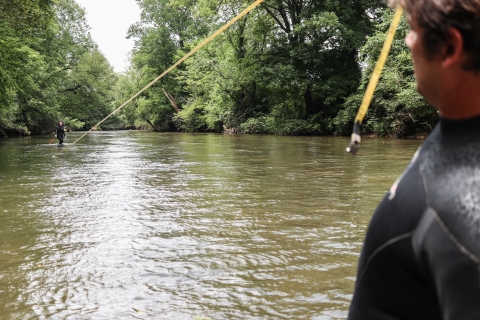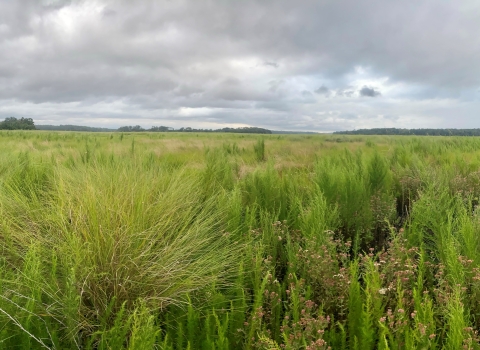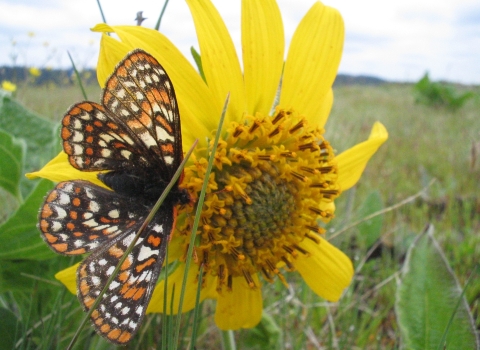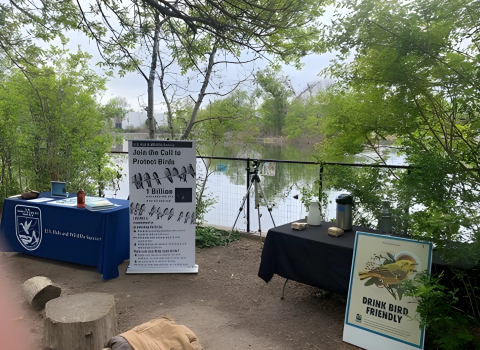As a trio of kids on inner tubes quietly floated down the French Broad River outside Rosman, North Carolina, a nearby snorkeler broke the river’s surface, disturbing the quiet with a quick clearing of water from his snorkel. U.S. Fish and Wildlife Service biologist Jason Mays was searching the river bottom for 300 wavy-rayed lampmussels, freshwater mussels stocked by the Service and the North Carolina Wildlife Resources Commission (NCWRC) in early June.
While tubing reflects the growing recreational, and economic, importance of the French Broad River, the mussels represent the ecological change happening in the river.
“When we stocked the wavy-rayed lampmussel in June, we returned it to the French Broad River after at least a 100-year absence,” said Luke Etchison, the lead NCWRC biologist working on the project.
On this particular afternoon, Mays and his team accounted for 252 of the mussels, making him happy.
“The data is showing this is a good site for mussels – the stream bottom is really stable,” he said. “There have been several intense rainstorms and the mussels are still here.”
In the early 20th century, biologist Arnold Ortmann, of the Carnegie Museum and the University of Pittsburgh, noted the absence of any mussels in the Asheville area, attributing the absence to lumber industries on the Davidson River, a tributary to the French Broad. Along Old Rosman Highway, near where biologists stocked the mussels, a historical marker notes the site of the Toxaway Tanning Company, which operated from 1901 until 1958 and was a major force in the development of Rosman. Another tannery once sat in today’s Asheville River Arts District. The Ecusta paper mill operated on the lower Davidson River for more than 60 years. It’s likely such industrial operations took their toll on the river’s water quality during the past century, in addition to heavy erosion as forests were cleared all over the French Broad River basin.
In 1974, Congress passed the Clean Water Act, a pivotal moment for river health across the nation. Increased attention to water quality has come from state and local governments, non-profits, and private individuals, with groups like RiverLink, Conserving Carolina, and Asheville Greenworks active in the French Broad watershed. Although the French Broad River still faces challenges, it is in much better shape than in 1955, when local author Wilma Dykeman described the polluted state of the French Broad River in her book French Broad, asking, in a chapter title, “Who Killed the French Broad?”
Another good sign: During the course of monitoring the stocked mussels, biologists found an endangered Appalachian elktoe mussel. It’s a species that has been on the endangered species list since 1994 and is only found in western North Carolina and a sliver of east Tennessee. The discovery marked a three-mile upstream range expansion for the elktoe.
To raise the stocked wavy-rayed lampmussels, biologists took female mussels from the nearby Pigeon River to the NCWRC’s Conservation Aquaculture Center in Marion, North Carolina, where larval mussels less than a millimeter long were grown to 30mm. Raising mussels in captivity can be tricky, because to transition out of the larval phase they must spend time attached to fish gills, where they receive nourishment for their metamorphosis. This means biologists were not only caring for the mussels, but also the fish on which the mussels depend.
While in captivity, the mussels received an identification chip, much like household pets, glued to the outside of their shell. The identifying number is picked up when a chip reader passes over a mussel buried in the stream bottom. The chips are part of a UNC-Asheville undergraduate research project by Brittany Barker-Jones, comparing a biologist’s ability to find the mussels via snorkeling versus finding the mussels by sensing their chips.
The French Broad site is just one in a broader effort. In addition to the 300 individuals stocked in the French Broad River, 200 were stocked in the Big Ivy River, another French Broad River tributary. Biologists haven’t been as successful in monitoring those individuals, speculating that high flow from summer rains combined with a less-stable stream bottom to scatter the mussels downstream. This fall, biologists will continue stocking efforts, returning to the Big Ivy River and the French Broad River, though this time near Hot Springs. They’ll also release mussels into the Swannanoa River for the first time.
The wavy-rayed lampmussel is considered a species of state special concern by the state of North Carolina. While the mussel isn’t federally threatened or endangered, the lessons learned from this stocking effort will guide work to fully restore the endangered Appalachian elktoe to the French Broad River.
“Stocking the wavy-rayed lampmussel is just a step in restoring the native fauna of the French Broad River,” said Etchison. “The wavy-rayed lampmussel is fairly common in some other streams, and fairly easy to propagate in captivity. We’re starting with easy species to see how to do it most efficiently and effectively. By doing so, we’re laying groundwork for other mussels.”





